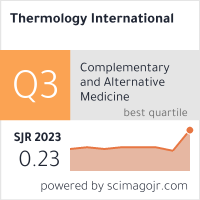American Academy of Thermology
Deutsche Gesellschaft für Thermographie & Regulationsmedizin
European Association of Thermology
Find volumes prior to 2012 in Archive
A Systematic Study to Evaluate the Benefit of using a Visualization Tool for Breast Thermography
Siva Teja Kakileti1, Geetha Manjunath1, Himanshu Madhu1, Lakshmi Krishnan1, H V Ramprakash2
1Niramai Health Analytix Pvt. Ltd, Bangalore, India.
2Central Diagnostic Research Foundation, Bangalore, India.
Breast thermography is a non-contact, non-invasive, and irradiation free imaging modality that is found to be applicable for detection of breast cancers. One of the main challenges with breast thermography is the subjectivity and the accuracy of visual interpretation of thermal images. In this paper, we present a systematic retrospective study that measures the performance of manual interpretation of breast thermal images and also evaluates the benefit of using a software visualization tool to aid this interpretation. The thermal analysis and visualization tool considered for this study was SMILE-100, which automatically transforms the temperature values into contrast-enhanced colour images and annotates elevated temperature regions to help thermologists in detection of signs of malignancy. The study was conducted in 258 symptomatic women and the reference used was the standard recommendation for diagnosing breast cancer involving a combination of mammography, ultrasound, and biopsy. The sensitivity and specificity of the thermologist's assessment without tool support was found to be 60.3% (95%CI: 48.2% to 72.4%) and 81.5% (95%CI: 76.1% to 87.0%), respectively. When the same thermologist was aided with SMILE-100 tool after a washout period of two months, a sensitivity and specificity of 81.0% (95% CI: 71.2% to 90.6%) and 75.9% (95% CI: 69.9% to 81.9%), respectively, was observed. Furthermore, the sensitivity and specificity of tool generated Hotspot annotations was found to be 85.7% (95%CI: 77.1% to 94.4%) and 70.3% (95%CI: 63.8% to 76.7%), respectively. These results show that SMILE-100 can be a good tool to improve the interpretation accuracy of thermal images and reduce the subjectivity in interpretation.
KEYWORDS: Visualization tool, computer aided thermography, annotated thermal images, quantitative thermal parameters.
EINE SYSTEMATISCHE STUDIE ZUM NUTZEN EINES VISUALISIERUNGSTOOLS F�R DIE BEWERTUNG DER BRUSTTHERMOGRAPHIE
Die Brustthermographie ist eine berührungslose, nicht-invasive und bestrahlungsfreie bildgebende Modalität, die für den Nachweis von Brustkrebs anwendbar ist. Eine der größten Herausforderungen bei der Brustthermographie ist die Subjektivität und Genauigkeit der visuellen Interpretation von Wärmebildern. In diesem Beitrag stellen wir eine systematische retrospektive Studie vor, die die Leistung der manuellen Interpretation von Brustwärmebildern misst und auch den Nutzen eines Software-Visualisierungstools zur Unterstützung dieser Interpretation bewertet. Das für diese Studie in Betracht gezogene thermische Analyse- und Visualisierungstool heißt SMILE-100, das die Temperaturwerte automatisch in kontrastverstärkte Farbbilder umwandelt und erhöhte Temperaturbereiche kennzeichnet, um den Thermologen bei der Erkennung von Malignitätszeichen zu helfen. Die Studie wurde in 258 symptomatische Frauen durchgeführt und als Referenz wurde die Standard-Empfehlung für die Diagnose von Brustkrebs mit einer Kombination von Mammographie, Ultraschall, und Biopsie verwendet. Die Auswertung des Thermologen ohne Werkzeugunterstützung erzielt eine Sensitivität von 60,3% (95%CI: 48,2% bis 72,4%) und eine Spezifität von 81,5% (95 %CI: 76,1%bis 87,0 %). Wenn derselbe Thermologe zwei Monaten später bei einer wiederholten Auswertung mit dem SMILE-100-Werkzeug unterstützt wurde, veränderte sich die Sensitivität auf 81,0% (95% CI: 71,2% bis 90,6%) und die Spezifität auf 75,9% (95%CI: 69,9%bis 81,9 %). Darüber hinaus wurde festgestellt, dass die vom Visualisierungstool vorgenommene Hotspot-Kennzeichnung eine Sensitivität von 85,7% (95 %CI: 77,1%bis 94,4 %) und eine Spezifität von 70,3% (95 %CI: 63,8%bis 76,7 %) zeigte. Diese Ergebnisse zeigen, dass SMILE-100 ein gutes Werkzeug sein kann, um die Interpretationsgenauigkeit von Wärmebildern zu verbessern und die Subjektivität bei der Interpretation zu reduzieren.
SCHLÜSSELWÖRTER: Visualisierungtool, computergestützte Thermografie, gekennzeichnete Wärmebilder, quantitative thermische Parameter.
Thermology international 2021, 31(2) 53-61
